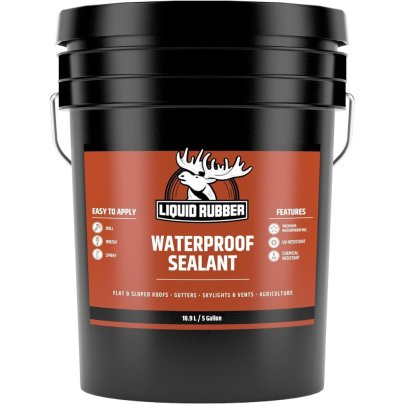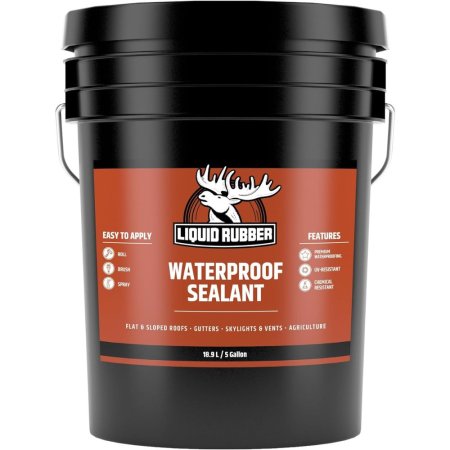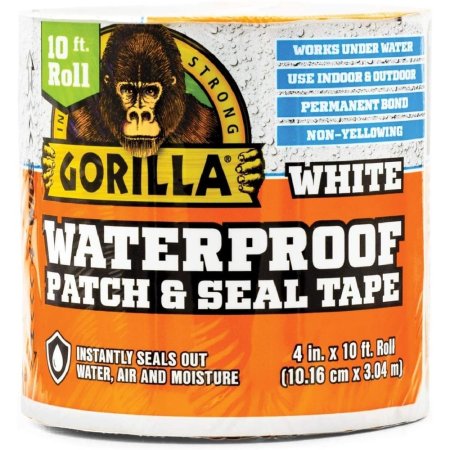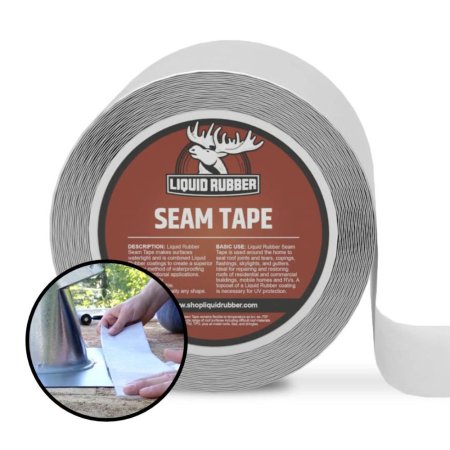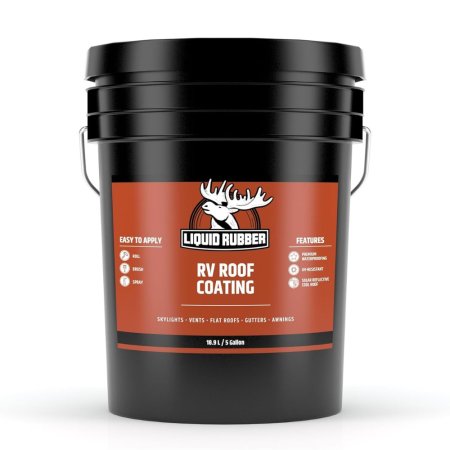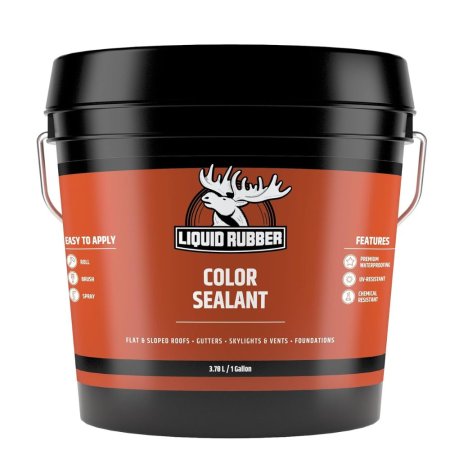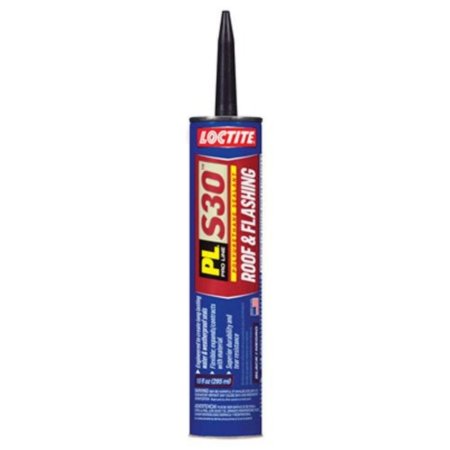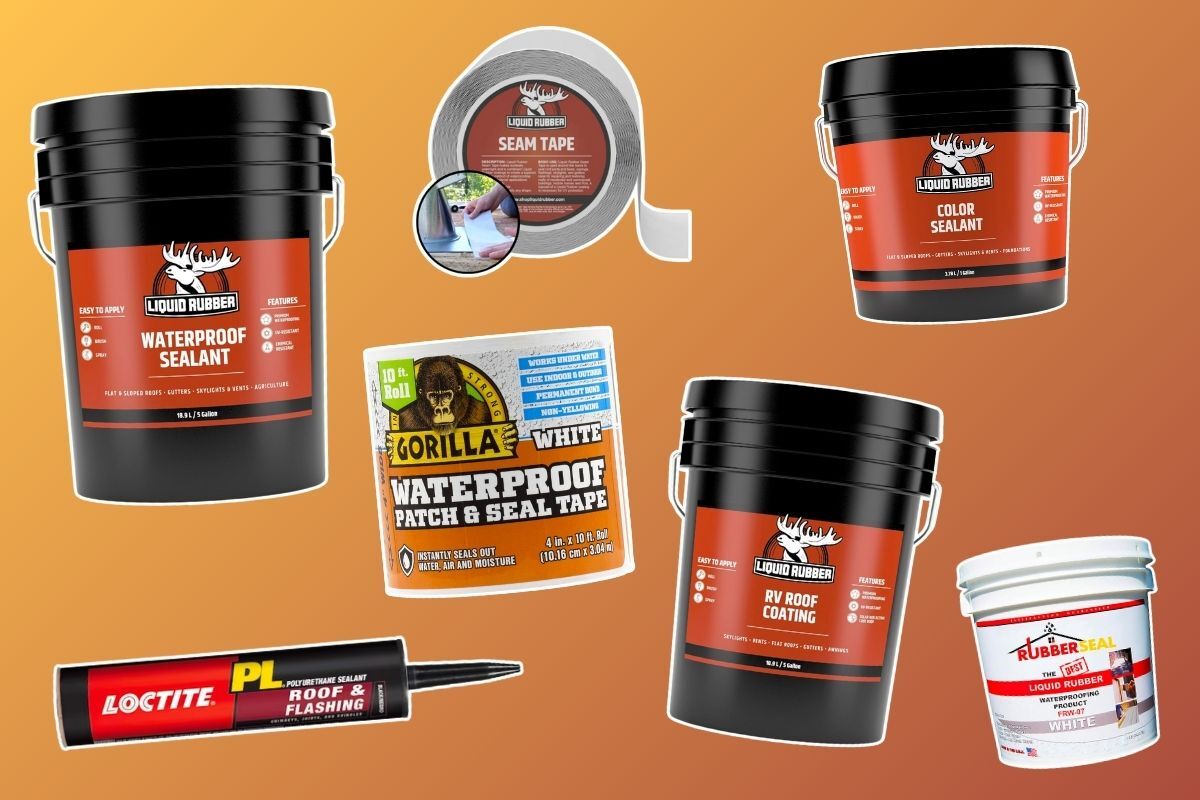
We may earn revenue from the products available on this page and participate in affiliate programs. Learn More ›
Roofs are designed to withstand an impressive onslaught of extreme weather, but daily exposure to sun, rain, hail, or snow can eventually degrade even the toughest roofs. The small leaks and weakened sections that form can let in moisture that may result in the need for expensive repairs, or even a new roof.
By filling little gaps and damaged sections with a sealant, DIYers can make protecting and repairing a roof an easier and more affordable task. While some products are meant for small and isolated leaks, others are designed to create a virtually impenetrable barrier over the entire roof. If you need to repair your roof or extend its life, keep reading to learn how we chose the seven best roof sealants for various roofing materials. Our favorite was the waterproof sealant from Liquid Rubber thanks to its thick consistency and good blending properties. After putting these picks through 2 weeks of hands-on testing, we have tangible insight to give on each one’s pros, cons, and best uses.
- BEST OVERALL: Liquid Rubber Waterproof Sealant
- BEST BANG FOR THE BUCK: Gorilla Waterproof Patch & Seal Tape
- BEST FOR LEAKS: Liquid Rubber Peel & Stick Seam Tape
- BEST FOR RV ROOFS: Liquid Rubber RV Roof Coating
- BEST FOR FLAT ROOFS: Rubberseal Liquid Rubber Waterproofing
- BEST FOR METAL ROOFS: Liquid Rubber Color Waterproof Sealant
- BEST FOR FLASHING: Loctite PL Roof and Flashing Polyurethane Sealant
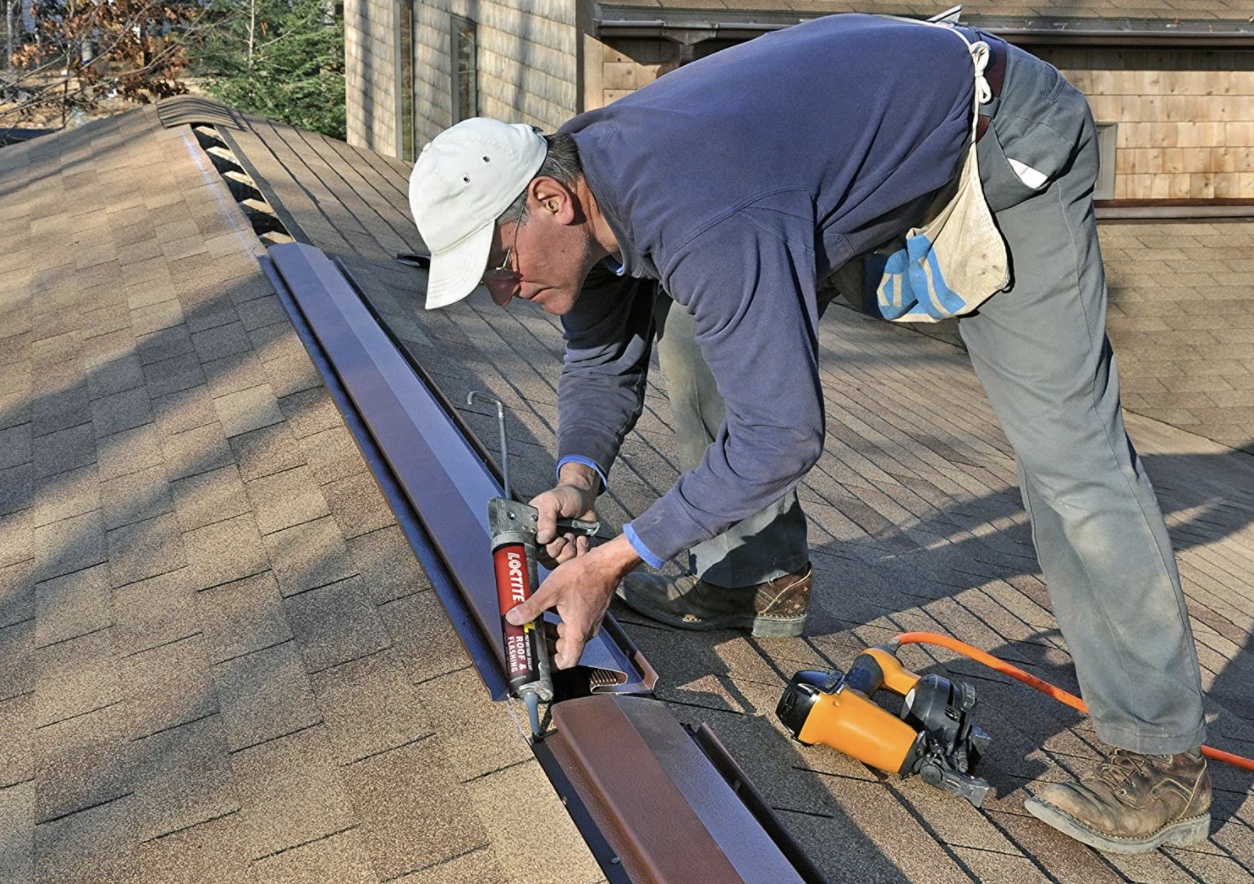
Product Comparison
| Type | Amount | Application | |
| Liquid Rubber Waterproof Sealant | Water-based polymer | 1 quart, 1 gallon, 5 gallons | Brush, roller, or sprayer |
| Gorilla Waterproof Patch & Seal Tape | Tape | 10 feet | Manual |
| Liquid Rubber Peel & Stick Seam Tape | Tape | 50 feet long by 2 or 4 inches wide | Manual |
| Liquid Rubber RV Roof Coating | Polyurethane | 1 quart, 1 gallon, or 5 gallons | Brush, roller, or sprayer |
| Rubberseal Liquid Rubber Waterproofing | Liquid rubber | 1 quart, 1 gallon, 2 gallons, or 5 gallons | Brush, roller, or sprayer |
| Liquid Rubber Color Waterproof Sealant | Liquid rubber | 1 gallon, 5 gallons | Brush, roller, or sprayer |
| Loctite PL Roof and Flashing Polyurethane Sealant | Polyurethane | 10 fluid ounces | Standard cartridge gun |
Our Top Picks
To make selecting an appropriate sealant easier, we tested the following top picks and categorized them by roof type or need. Since all of these products proved themselves to be capable waterproofers that work as the manufacturer suggests, we considered ease of application, odor, and value when determining which roofing sealants were best.
Best Overall
Liquid Rubber Waterproof Sealant
What We Like
- Thicker than most of the other sealants we tested
- Blends in well if users sprinkle some shingle grit on top
- Adhered very well to plywood and shingle surfaces
What We Don’t Like
- Consistency might be a little too thick for some sprayers
Product Specs
- Type: Water-based polymer
- Amount: 1 quart, 1 gallon, 5 gallons
- Application: Brush, roller, or sprayer
Regardless of the roof material or the climate, Liquid Rubber’s sealant is designed to protect. It’s capable of creating a waterproof membrane on metal, shingle, or rubber roofs that are either flat or sloped. The rubber coating this sealant creates is so resilient against standing water that it can be used on the bottom of planter boxes or gutters; thus, it can certainly protect a roof from rain or snow. This sealant is also ultraviolet (UV) resistant to help shield a roof from aggressive sun exposure.
During our test, we found Liquid Rubber waterproof sealant to be the most dependable. It’s thicker than many other materials, so it’s great for filling in gaps or larger cracks as well as creating a good barrier in one coat. It’s also the most “blendable” of the products we tested, allowing us to hide a repair on a black asphalt roof with a bit of roofing grit sprinkled on top. It adheres very well to plywood and asphalt, but because it’s thicker, it may need to be thinned to be sprayed, which can affect its durability and elastic properties.
Get the Liquid Rubber waterproof roof sealant at Amazon, Lowe’s, Walmart, or Liquid Rubber.
Best Bang for the Buck
Gorilla Waterproof Patch & Seal Tape
What We Like
- Very easy to apply
- Much thicker and far more adhesive than duct tape
- Application surfaces don’t have to be dry
What We Don’t Like
- Users only get 1 chance to apply it without bubbles
Product Specs
- Type: Tape
- Amount: 10 feet
- Application: Manual
For those who need to repair only a small section of roofing and don’t want to purchase an entire container of liquid sealant, Gorilla’s 10-foot roll of seal tape is a solid, budget-friendly option. This waterproof tape creates a permanent bond that can patch a leak on a variety of roofing materials, including metal, rubber, plastic, and wood. While it works best if applied on a warm and dry day, it can also be used during cold, hot, humid, and wet weather. It can even be used underwater; however, it’s not designed to patch asphalt shingles and may not stick to a roof already treated with a liquid sealant or other water-repellent material.
During our test, the Gorilla waterproof tape was easy to apply, requiring us to simply cut, peel, and stick it. But we quickly realized we only had one chance to get it on without bubbles—it cannot be repositioned once it’s attached. The tape is thick and durable (much thicker and gooier than a piece of duct tape), but the adhesive is so strong that it can damage the material underneath it. Its strong adhesive ability means users can apply it underwater or on wet surfaces, making it an excellent choice for emergency repairs.
Get the Gorilla roof sealant at Amazon, Lowe’s, Ace Hardware, The Home Depot, or Walmart.
Best for Leaks
Liquid Rubber Peel & Stick Seam Tape
What We Like
- Can be used to repair a leak or as flashing tape
- Adhesive is very strong
- Creates a structural bond when combined with roofing sealant
What We Don’t Like
- Somewhat expensive for the amount of tape received
- Has to be combined with roofing sealant for the intended bond
Product Specs
- Type: Tape
- Amount: 50 feet long by 2 or 4 inches wide
- Application: Manual
To prevent small roof leaks from creating expensive damage down the road, Liquid Rubber’s seal tape can quickly and easily seal leaks on a variety of roofing materials. This seal tape comes in 2- or 4-inch-wide strips with an adhesive backing that sticks to metal, shingles, and rubber. It can be applied without additional tools and doesn’t require any surface protection or cleanup.
After testing, we almost removed this tape from our list. While it’s great at what it does, there are some caveats users will want to understand. For one, it has to be coated with an additional roofing sealant to be protected from UV rays. Also, it’s relatively expensive for the amount of tape received. But if users know how to use it, it’s a superior product: It can serve as a leak repair tape or flashing, and the adhesive is extremely strong. It created a structural bond between the boards we sealed together, likely due to the mesh backing and its absorbing the roofing sealant.
Get the Liquid Rubber roof sealant tape at Amazon, Lowe’s, or Liquid Rubber.
Best for RV Roofs
Liquid Rubber RV Roof Coating
What We Like
- Thinner material can be sprayed without diluting with water
- Enough material for multiple coats to most RV roofs
- Flexible compound won’t crack
What We Don’t Like
- Requires a primer coat
Product Specs
- Type: Polyurethane
- Amount: 1 quart, 1 gallon, or 5 gallons
- Application: Brush, roller, or sprayer
A leaky RV roof can quickly cause extensive damage to the RV’s interior, but Liquid Rubber’s roof coating is specifically formulated to protect against this costly problem. It creates a waterproof and UV-resistant rubber coating over an RV’s rubber or metal roof, which should keep it cool during the summer and protect it from weather damage year-round.
The rubberized membrane has a high level of flexibility, making it perfectly suited for the constant movement of an RV. One 5-gallon container is enough to provide two to three coats on an RV up to 30 feet long, so users may only need a single bucket to seal the entire roof. For users who only need to cover existing leaks or cover vulnerable seams, this sealant is also available in 1-quart and 1-gallon containers.
Liquid Rubber’s RV coating is thinner than almost all the other roofing sealants we tested, meaning users can spray it without clogging their sprayers. However, it’s important to note that this sealant requires a primer, so while one 5-gallon bucket can cover an entire RV roof, users must prime the roof first. Since it’s a highly flexible sealant, it’s a great choice for withstanding the rigors of driving along bumpy and uneven roads.
Get the Liquid Rubber RV roof sealant at Amazon, Lowe’s, or Liquid Rubber.
Best for Flat Roofs
Rubberseal Liquid Rubber Waterproofing
What We Like
- Material is thin enough to spray without diluting with water
- Emits a very low (if any) odor during application
- Reflects UV rays to keep surfaces cool; Energy Star certified
What We Don’t Like
- Doesn’t feel quite as elastic as the other roofing sealants we tested
Product Specs
- Type: Liquid rubber
- Amount: 1 quart, 1 gallon, 2 gallons, or 5 gallons
- Application: Brush, roller, or sprayer
Flat roofs are particularly susceptible to damage caused by water seeping inside leaks or cracks, and preventing issues caused by pooling water on flat roofs is where Rubberseal’s roof seal really stands out. It provides a protective membrane that’s moisture-resistant and virtually impenetrable to standing water while also possessing high solar reflectivity to keep a roof cool and protected all summer long.
Rubberseal offers this sealant in several colors, including white, black, light gray, and dark gray, to suit different aesthetic preferences and UV-resistance needs. We didn’t have a way to time-collapse and intensify the sun’s damage on this roofing sealant during our test, but the white version we tested certainly appeared to reflect the sun and stay cooler than other sealants. Its thick, solvent-based formula is easy to apply with a paint roller or brush; we also found it thin enough to spray. It had minimal odor, and we liked that it didn’t require a primer. Our only complaint is that it didn’t feel quite as flexible as some of the other compounds.
Get the Rubberseal roof sealant at Amazon or The Home Depot.
Best for Metal Roofs
Liquid Rubber Color Waterproof Sealant
What We Like
- Thinner and easier to apply
- Available in multiple colors
- Adheres well to plywood
What We Don’t Like
- Thinning it may affect its color and make it hard to replicate
Product Specs
- Type: Liquid rubber
- Amount: 1 gallon, 5 gallons
- Application: Brush, roller, or sprayer
For a sealant specifically formulated for metal roofs, this option from Liquid Rubber is hard to beat. The water-based formula can be applied with a brush, roller, or sprayer, and it dries into a moisture- and UV-resistant thick rubber membrane. The waterproof barrier it creates is resilient against pooling water, so it can be used on flat roofs as well as sloped.
We expected this product to be exactly the same as the waterproofing sealant from Liquid Rubber, but it was thinner and easier to apply, though just as difficult to remove. We liked that it’s available in multiple colors (our test bucket was white and very bright), which will please folks looking to give their metal-roofed buildings a fresh new look. This sealant’s specialized nature gives it an edge on metal roofs, but it can also be used on concrete and wood. Note that applying it in thin layers affects the color, which makes it harder to replicate.
Get the Liquid Rubber color roof sealant at Amazon, Lowe’s, or Liquid Rubber.
Best for Flashing
Loctite PL Roof and Flashing Polyurethane Sealant
What We Like
- Easy to apply a thick, controllable bead
- Can be used for flashing vents, adhering shingles, and more
- Thick enough to fill larger cracks and gaps
What We Don’t Like
- Can be difficult to use in colder weather
Product Specs
- Type: Polyurethane
- Amount: 10 fluid ounces
- Application: Standard cartridge gun
Flashing is an important moisture barrier, and flashing damaged by storms or age can leave a roof vulnerable to moisture exposure. Just like any other crack or leak in a roof, damage to the roof flashing needs to be repaired to restore its moisture-resistant integrity. Loctite’s roof flashing sealant was made specifically for this purpose.
We’ve been using Loctite’s PL roof and flashing sealant for years before testing it for this guide. It’s perfect for laying down thick, controllable beads of sealant and will stick to almost any surface. We’ve used it to seal flashing for vents, adhere ridge cap shingles, and seal large cracks and gaps. Our only qualm is that it’s hard to apply when it’s cold.
Get the Loctite roof sealant at Lowe’s, Ace Hardware, or The Home Depot.
Jump to Our Top Picks
How We Tested the Best Roof Sealants
We wanted to ensure that we were suggesting only the best roofing sealants because a mistake here could leave us (and our readers) all wet. After reviewing popular and well-reviewed options, we ordered seven top sealants and put them to the test. Since we had a roofing project coming up, it was the perfect opportunity to take some of these products for a spin.
First, we wanted to test how difficult each product was to apply. We followed the manufacturer’s instructions (most recommend three coats), applying the sealants to our roof as well as a sheet of sheathing for side-by-side comparisons. To test the tapes and caulk, we covered some gaps we created between scrap boards and left them out in the rain and snow.
At the end of the 2-week test period, we scored each product and gave it an award based on performance. Overall, these products do exactly as they claim: create effective barriers against moisture and seal gaps.
What to Consider When Choosing a Roof Sealant
With so many roof sealants on the market, choosing the best one for your specific needs can be difficult. To narrow down the choices, it helps to review and compare the characteristics of roof sealants. The following considerations can help take the guesswork out of determining the best roof sealant for you.
Purpose
Roof sealants serve two main purposes: protecting roofs by creating a barrier against moisture and sun and repairing minor leaks before they cause serious damage. Although some roof sealants will be effective on virtually any type of roof, most are formulated to work with specific roofing materials.
Roofing materials like asphalt shingles, composite shingles, metal, and rubber have different characteristics that require special attention when choosing a sealant. Additionally, whether a roof is flat or slanted can impact which sealant is ideal. Finally, whether the goal is to repair minor damage or seal an entire roof also needs consideration when choosing the best type of roof sealant.
Type
Roof sealants can be divided into two categories: solvent-based and water-based. While solvent-based sealants are highly resilient against the elements, they are generally more expensive, thicker, and harder to apply. Water-based sealants are more affordable and emit fewer odors, but they aren’t as weather resilient. They may degrade several years earlier than solvent-based sealants and, therefore, may require more frequent maintenance.
Solvent-based sealants also require using a respirator during application to avoid inhaling the solvent fumes, whereas no mask is needed for water-based sealants. Disposing of solvent-based sealants can also be trickier since they may be considered household hazardous waste and must be disposed of at an appropriate facility. Water-based sealants can be discarded in a household trash bin after the container’s contents have fully dried.
Within the two main categories, there are five types of roof sealants: acrylic, polyurethane, silicone, rubber, and sealant tape.
- Acrylic: The most common variety, acrylic roof sealants are specifically made to deflect UV rays. They are popular in western and southwestern states where sun damage to roofs may be the primary concern. Acrylic sealants are also moderately moisture-resistant but don’t provide a waterproof barrier or hold up well against standing pools of water, which is a common issue on flat roofs.
- Polyurethane: Polyurethane sealants are resilient against moisture but not very resilient against UV rays. This makes polyurethane sealants preferable in areas with more rain and snow than sun.
- Silicone: Silicone sealants offer excellent protection against moisture and UV rays, making them suitable for any weather, including heavy rain and sun. The main downside of silicone sealants is that they’re often expensive, which can make coating a whole roof financially prohibitive.
- Rubber: Rubber sealants consist of liquid rubber that acts as a powerful guard against sun and rain. These sealants are often available in thin, water-based formulas that are easy to apply. Their watery consistency makes them great for sealing small cracks and leaks.
- Sealant tape: Sealant tape is a thin strip of moisture-resistant material for repairing minor leaks and sealing vulnerable roof seams. The tape has an adhesive backing that applies directly to the roofing material, making it easy to use without a messy or labor-intensive application process. Sealant tape is generally more affordable than other types of sealants, but it’s not designed to cover large sections of a roof.
Waterproofing
Every type of roof sealant offers some protection against water, but not all are capable of producing a completely waterproof membrane. If the main goal is waterproofing the roof, the best sealant types are rubber, silicone, and polyurethane. Each tolerates heavy rain and pooling water that acrylic sealants and sealant tapes can’t handle.
Regardless of the type of sealant used, multiple coats are often required to create a completely waterproof seal over the entire roof. If that’s the intended purpose, it’s especially important to follow the manufacturer’s directions for application. Repairing isolated leaks may be an exception, however, as a single coat of most sealants is sufficient for waterproofing small areas.
Reflectivity
A roof’s solar reflectivity is the amount of sunlight it’s capable of reflecting, which translates into less heat absorption, which equates to an overall cooler home, reduced air conditioning use, and a lower electricity bill. Depending on the sealant’s material and color, adding a layer of roof sealant can dramatically enhance a roof’s solar reflectivity. Some manufacturers claim their products can deflect up to 92percent of UV rays.
Rubber, acrylic, silicone, and polyurethane sealants all possess high levels of reflectivity. Along with the sealant’s material composition, the color of the sealant will play a major role in its level of reflectivity. White and light-colored sealants generally possess the highest reflectivity, while black and darker-colored sealants offer the lowest reflectivity.
Longevity
A roof sealant’s longevity will vary among manufacturers and the sealant’s material, but most will last between 10 and 20 years. Sealant tapes will usually last this long without any special application process, but the longevity of liquid sealants depends on the thickness of the applied coating. A coating of liquid sealant 30 mils (a mil is equal to 1/1000 inch) thick can last 10 years longer than a sealant 20 mils thick. Obtaining the proper thickness might require several coats of sealant, and sealant manufacturers will often specify the required coats to obtain the desired thickness.
Another factor that impacts a roof sealant’s longevity is proper application; a roof sealant applied during cold weather, to a wet or dirty roof, or before rain without adequate time to cure, won’t last as long as a correctly applied sealant. Maintaining the performance includes inspecting the roof at least once a year under normal weather conditions and repairing any damage after adverse weather, like heavy rain, snow, and intense sun exposure. Some sealant manufacturers and roofing contractors recommend resealing a roof every 5 years, regardless of its condition, to maximize longevity.
Ease of Application
Thicker, solvent-based sealants, like silicone and some rubber sealants, are harder to apply than water-based sealants, like acrylic and water-based rubber sealants. However, thinner sealants will likely require multiple coats to achieve the necessary thickness, especially when aiming for a waterproof seal on the entire roof. Also, thicker sealants may be easier to work with in hot weather since thin sealants can become too runny to achieve a thick coat.
Both thick and thin sealants can be applied with a paint brush or a roller, but with thinner sealants, there is the additional option of using a paint sprayer. For isolated repair work, sealants in caulking tubes can more easily access nooks and crannies that would be difficult to reach with a brush, and sealant tapes can be easily applied to the affected area with minimal effort and no additional tools.
FAQs
Q. How do you use roof sealant?
Depending on the sealant’s thickness, you can apply it with a paint brush, paint roller, paint sprayer, or hand trowel. Some roof sealants come in tubes that are applied with caulk guns.
Q. How long does a roof sealant take to dry?
The drying time for a roof sealant will depend on the sealant’s composition and the weather at the time of application. Most sealants take between 8 and 24 hours to fully dry.
Q. How do you remove roof sealant?
You can usually use a plastic putty knife to remove roof sealant. Just be careful not to damage the underlying roofing material.
Meet the Tester
Tom Scalisi is a full-time DIY and construction writer for many of the largest websites in the industry, including BobVila.com, This Old House, Family Handyman, and Forbes as well as his own pest control blog.
Additional research provided by James Fitzgerald.
